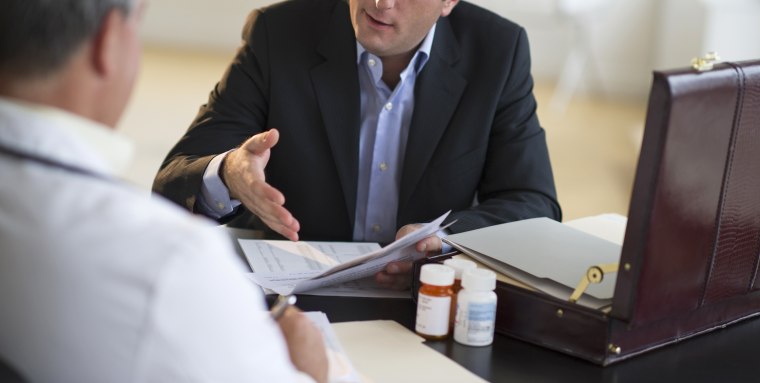About one out of every 12 U.S. doctors gets money, lunch or something else of value from companies that make opioid drugs, researchers reported Wednesday.
Companies are spending much more time and effort marketing opioids to doctors than they are other, less addictive painkillers, the researchers found. They say their findings help explain why doctors have played such an important role in the opioid overuse epidemic.

“A large proportion of physicians received payments — one in 12 physicians overall,” said Dr. Scott Hadland of the Boston Medical Center. “Tens of millions of dollars were transferred for marketing purposes for opioids.”
Hadland and colleagues went through databases from the Centers for Medicare and Medicaid Services, the federal government office that oversees public health insurance. The 2010 Affordable Care Act includes the Physician Payments Sunshine Act, which requires medical product makers to report any payments or offerings of value made to doctors or to teaching hospitals.
“In some cases they are money provided directly to physicians — for example, the speaking fees, the consultant fees and the honoraria. In other cases it is reimbursement for things like travel,” Hadland said. They also include meals.
"One of the main drivers of the epidemic has been the vast overprescribing of prescription pain medications."
Between 2013 and 2015, the team found 375,266 payments worth $46 million made to more than 68,000 doctors.
On average, a doctor got a single “payment” — usually a meal — worth an average of $15 once a year. But some really cashed in. “The top 1 percent of physicians (681 of them) received 82.5 percent of total payments in dollars,” the team wrote in their report, published in the American Journal of Public Health.
Related: One in Five Americans Got an Opioid Rx
While the big payments mostly accounted for speaker fees, food and drink accounted for 94 percent of the payments.
“I do think the practice is exceedingly common. Increasingly, medical schools are restricting the ability of pharma companies to come to speak to medical students and even faculty,” Hadland said.
So what? Can a doctor really be bought for the price of a boxed lunch? Research indicates that these little goodies do influence prescribing.
A study published last year found that physicians who accepted even one meal sponsored by a drug company were much more likely to prescribe a name-brand drug to patients later.
Related: Free Pens and Pizza Come at a Cost
After earlier studies and controversies, the Pharmaceutical Research and Manufacturers of America, the lobby group that represents big drugmakers, issued a voluntary code of conduct to curb the once widespread practice of handing out free mugs, prescription pads and other swag covered in drug brand names.
Some cities and states especially hard hit by the opioid abuse epidemic have even sued drugmakers, saying their practices have helped fuel the problem.
The Centers for Disease Control and Prevention says doctors are definitely helping drive the addiction crisis, prescribing opioids to too many patients, at doses that are often too high and for too long.
The result is deadly. More than 30,000 Americans died from opioid overdoses in 2015, the federal government said.
“Yes, we want to make sure people’s pain is appropriately treated, but we know that longer and higher doses have significantly added to the addiction problem that we have in the United States.”
“I think that first and foremost we have known that one of the main drivers of the epidemic has been the vast overprescribing of prescription pain medications,” said Michael Botticelli, former director of the White House Office of National Drug Control Policy who is now executive director of the Grayken Center for Addiction Medicine at the Boston Medical Center.
“A huge lift in fighting this epidemic has been reining in those prescribing practices. (The findings) demonstrate how pervasive the pharmaceutical industry has been in influencing prescriptions.”
Drug companies and many doctors argue that it’s not so simple. Education on how a drug works is important.
Botticelli says the answer is independent education, free of the need to promote a specific product.
“At the federal and state level (we may need to) move toward mandatory prescriber education to counteract industry’s influence over prescribing behavior,” he said. "Clearly, guidelines are not enough."
Related: Trump Says U.S. Will Beat Opioid Crisis
“The CDC has guidelines. Specialty associations have implemented those guidelines, but uptake has been slow. Education on addiction really needs to happen as part of a core medical school curriculum, core dental school curriculum and nursing school curriculum.”
The CDC recommends starting with non-opioid medications or even physical therapy, ice and other non-drug treatment for pain.
Botticelli says while pain is a big problem, the answer is not more opioids.
“In 2012 we were prescribing enough prescription pain medication to give every adult American their own prescription for pain medication,” he said.
“Yes, we want to make sure people’s pain is appropriately treated, but we know that longer and higher doses have significantly added to the addiction problem that we have in the United States.”
